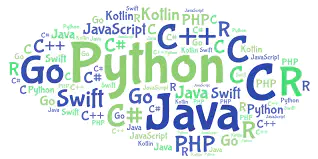Programming languages
 Image credit: Unsplash
Image credit: Unsplash
Introduction.
There are a huge number of directions in IT: from creating games and applications to developing robots that completely replace human labor. There is no programming language that is equally fast at solving problems in any of these areas. So it’s important to understand that any lists of the best programming languages are subjective and usually based on how popular, versatile, and comfortable the language is.
Content.
- What are programming languages?
- Where are programming languages used?
- The top 5 programming languages currently in use.
**What are programming languages?
A programming language is a set of formal rules by which programs are written. A normal language is needed to communicate with people, but a programming language is needed to communicate with a computer. Like any natural language, it has a vocabulary - words, functions and operators - from which expressions are composed according to syntax rules. They have a clear, well-defined meaning, understandable to a computer - semantics.
**Where are programming languages used?
The uses of programming languages are very different. They depend on the area where the user wants to use them. For each area, there are “different” programming languages. Generally speaking, programming languages are used in web programming, game development, android development, Operating Systems development, software development, neural networks and data analysis.
**Top 5 programming languages currently
1. JavaScript language.
Don't confuse it with Java - they are different and totally different languages.
JavaScript is used for graphics, mobile and web applications, and browser-based operating systems. It's very versatile and easy to learn.
2. The Python language.
Python is easy to learn and is often used to teach children programming, such as at the Skysmart online school. Python programs are close to a natural language, so it's great as a first language for a beginning programmer.
It is a very common language and a large number of projects have been implemented in it. Python is used extensively at Google and much of the source code for YouTube is written in it. It's also often used in creating robot machines.
The strengths of Python are its modularity and its ability to integrate with other languages, while the downsides are its slow speed and high memory consumption.
3. Java language.
A general-purpose programming language that consistently ranks high in popularity ratings. Applications in Java can run on any computer, for this purpose a virtual Java-machine is created. Mobile applications for the Android operating system are actively being developed in Java.
Successful projects such as RuneScape, Yahoo, Amazon, eBay and LinkedIn are written in Java.
Disadvantages of Java are slow programs and high RAM consumption.
4. C# language.
The name of the language reads "C Sharp". It was developed in 1998-2001 within Microsoft for creating applications.
C# belongs to the family of languages with C-like syntax, of which it is closest to C++ and Java. That is why C# has a rather complex syntax, which is considered a disadvantage.
Compared to C and C++, C# has safe code. C# is dozens of times slower than C.
*5. rnr language.
Widely used for creating web applications, leading in applications for creating dynamic websites. PHP has undergone a rapid evolution and has become popular among programmers. However, it is often criticized by programmers for its inconsistent syntax.
Conclusion.
Thus, programming languages are very diverse and exist as long as the purposes for which they are used are relevant. There are now thousands of programming languages used for their purposes, with a large number of people working on them.